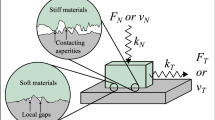Abstract
Interlocking asperities are shown to have a fundamental effect on the friction behavior of contacting solids through theoretically derived shear force–displacement relationship. The key aspect of this relationship is the asperity contact orientation probability distribution obtained using the random process theory in terms of measurable surface roughness parameters. Thus, the obliquity of surface asperity contact is included in the contact shear analysis in a fundamental manner. The interlocking asperities are found to result in a normal load-dependent friction coefficient for a contact. The interlocking also affects contact partial slip and the shear displacements that precede sliding. The derived relationship can be used to evaluate factors, such as asperity adhesion, plasticity, damage, normal-shear coupling and scale dependency, which are difficult to separate in experiments and atomistic simulations.



Similar content being viewed by others
References
Yaqoob, M.A., Winogrodzka, A., Fischer, H.R., Gelinck, E.R.M., de Rooij, M.B., Schipper, D.J.: Pre-sliding behaviour of single asperity contact. Tribol. Lett. 49(3), 553–562 (2013)
Gao, J.P., Luedtke, W.D., Gourdon, D., Ruths, M., Israelachvili, J.N., Landman, U.: Frictional forces and Amontons’ law: from the molecular to the macroscopic scale. J. Phys. Chem. B 108(11), 3410–3425 (2004). doi:10.1021/Jp036362l
Luan, B.Q., Robbins, M.O.: The breakdown of continuum models for mechanical contacts. Nature 435(7044), 929–932 (2005). doi:10.1038/Nature03700
Mo, Y.F., Turner, K.T., Szlufarska, I.: Friction laws at the nanoscale. Nature 457(7233), 1116–1119 (2009). doi:10.1038/Nature07748
Urbakh, M., Klafter, J., Gourdon, D., Israelachvili, J.: The nonlinear nature of friction. Nature 430(6999), 525–528 (2004). doi:10.1038/Nature02750
Bowden, F.P., Tabor, D.: The Friction and Lubrication of Solids. Clarendon, Oxford (1950)
Jones, R.E.: A Greenwood-Williamson model of small-scale friction. J. Appl. Mech-t Asme. 74(1), 31–40 (2007). doi:10.1115/1.2172269
De Moerlooze, K., Al-Bender, F.: On the relationship between normal load and friction force in pre-sliding frictional contacts. Part 2: experimental investigation. Wear 269(3–4), 183–189 (2010). doi:10.1016/j.wear.2010.02.008
Tworzydlo, W., Cecot, W., Oden, J., Yew, C.: Computational micro-and macroscopic models of contact and friction: formulation, approach and applications. Wear 220(2), 113–140 (1998)
Biegel, R.L., Wang, W., Scholz, C.H., Boitnott, G.N., Yoshioka, N.: Micromechanics of rock friction, 1. Effects of surface roughness of initial friction and slip hardening in Westerly Granite. J. Geophys. Res. Solid Earth 97, 8951–8964 (1992)
Longuet-Higgins, M.S.: The statistical analysis of a random, moving surface. Philos. Trans. R Soc. Lond. Ser. A Math. Phys. Sci. 249(966), 321–387 (1957)
Longuet-Higgins, M.S.: Statistical properties of an isotropic random surface. Philos. Trans. R Soc. Lond. Ser. a-Math. Phys. Sci. 250(975), 157–174 (1957)
Nayak, P.R.: Random process model of rough surfaces in plastic contact. Wear 26(3), 305–333 (1973)
Hertz, H.: On the contact of elastic solids. Journal fur de reine und angewandte Mathematik 92, 156–171 (1881)
Johnson, K.L.: Contact mechanics. Cambridge University Press, Cambridge (1985)
Cattaneo, C.: Sul contatto di due corpi elasti:distribuzione locale degli sforzi. Rendicotti dell’ Accademia dei lincei 27(6), 342–348 (1938)
Mindlin, R.D.: Compliance of elastic bodies in contact. J Appl Mech-t Asme 16(3), 259–268 (1949)
Savkoor, A.R., Briggs, G.A.D.: Effect of tangential force on contact of elastic solids in adhesion. Proc. R Soc. Lond. Ser. a-Math. Phys. Eng. Sci. 356(1684), 103–114 (1977). doi:10.1098/rspa.1977.0123
Thornton, C.: Interparticle sliding in the presence of adhesion. J. Phys. D Appl. Phys. 24(11), 1942–1946 (1991). doi:10.1088/0022-3727/24/11/007
Barthel, E., Haiat, G.: Approximate model for the adhesive contact of viscoelastic spheres. Langmuir 18(24), 9362–9370 (2002). doi:10.1021/La025959
Boucly, V., Nelias, D., Green, I.: Modeling of the rolling and sliding contact between two asperities. J. Tribol-t Asme 129(2), 235–245 (2007). doi:10.1115/1.2464137
Haiat, G., Barthel, E.: An approximate model for the adhesive contact of rough viscoelastic surfaces. Langmuir 23(23), 11643–11650 (2007). doi:10.1021/La701560n
Jackson, R.L., Green, I.: A statistical model of elasto-plastic asperity contact between rough surfaces. Tribol. Int. 39(9), 906–914 (2006). doi:10.1016/j.triboint.2005.09.001
Misra, A., Huang, S.: Micromechanical stress-displacement model for rough interfaces: effect of asperity contact orientation on closure and shear behavior. Int. J. Solids Struct. 49(1), 111–120 (2012). doi:10.1016/j.ijsolstr.2011.09.013
Amontons, G.: On the resistance originating in machines. In: Proceedings of the French Royal Academy of Sciences, pp. 206–222 (1699)
Coulomb, C.A.: Theorie des machines simples, en ayant egard au frottement de leurs parties, et a la roideur des cordages. Memoire de Mathematique et de Physics de l’Academie Royale des Sciences X, 161–342 (1785)
da Vinci, L.: Codex Atlanticus
Euler, L.: Sur le frottement des corps solides Memoires de l’academie des sciences de Berlin 4, 122–132 (1748)
Boitnott, G.N., Biegel, R.L., Scholz, C.H., Yoshioka, N., Wang, W.: Micromechanics of Rock Friction. 2. Quantitative modeling of initial friction with contact theory. J. Geophys. Res. Solid Earth 97(B6), 8965–8978 (1992)
Ford, I.J.: Roughness effect on friction for multi-asperity contact between surfaces. J. Phys. D Appl. Phys. 26(12), 2219–2225 (1993)
Misra, A.: Mechanistic model for contact between rough surfaces. J. Eng. Mech-asce 123(5), 475–484 (1997)
Yoshioka, N., Scholz, C.H.: Elastic properties of contacting surfaces under normal and shear loads. 1. Theory. J. Geophys. Res. Solid Earth Planets 94(B12), 17681–17690 (1989)
Acknowledgments
The authors would like to acknowledge the support from National Natural Science Foundation of China, Grant No. 11202080 and the Fundamental Research Funds for the Central Universities, Grant No. 2012ZB0024. A.M. is also supported in part by the United States National Science Foundation grant CMMI-1068528.
Author information
Authors and Affiliations
Corresponding author
Rights and permissions
About this article
Cite this article
Huang, S., Misra, A. Micro–Macro-Shear-Displacement Behavior of Contacting Rough Solids. Tribol Lett 51, 431–436 (2013). https://doi.org/10.1007/s11249-013-0178-y
Received:
Accepted:
Published:
Issue Date:
DOI: https://doi.org/10.1007/s11249-013-0178-y




